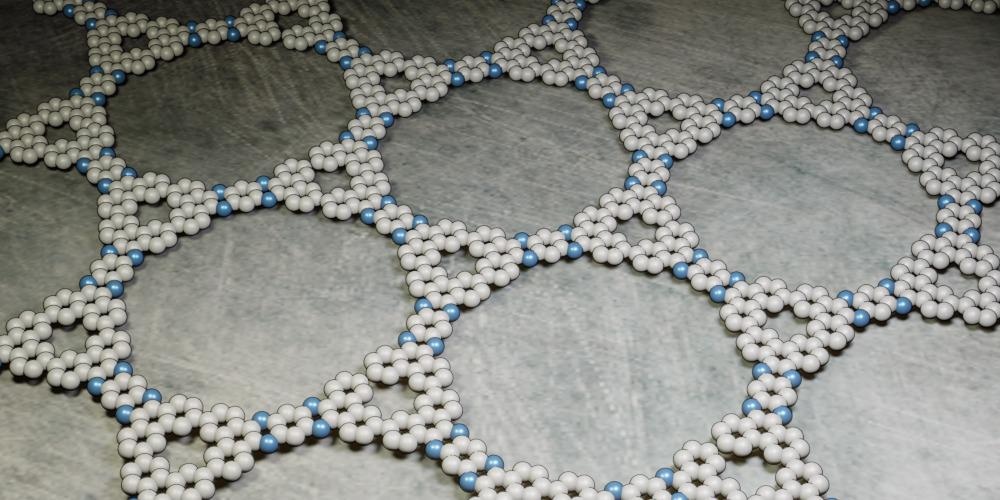Feb 16 2021
In a breakthrough study, physicists from the University of Basel have created for the first time a graphene compound containing carbon atoms and a few number of nitrogen atoms in a regular pattern of triangles and hexagons.
 Kagome graphene is characterized by a regular lattice of hexagons and triangles. It behaves as a semiconductor and may also have unusual electrical properties. Image Credit: R. Pawlak, Department of Physics, University of Basel.
Kagome graphene is characterized by a regular lattice of hexagons and triangles. It behaves as a semiconductor and may also have unusual electrical properties. Image Credit: R. Pawlak, Department of Physics, University of Basel.
This 'kagome lattice' with a honeycomb structure acts as a semiconductor and could also have exclusive electrical properties. In the days to come, the kagome lattice could perhaps be employed in quantum computers or electronic sensors.
Globally, scientists are looking for novel synthetic materials that have unique properties, like superconductivity. In other words, electric current is conducted without any resistance.
These innovative substances are a significant step in the advancement of extremely energy efficient electronics. The preliminary material is usually a single-layer honeycomb structure of graphene or carbon atoms.
Hypothetical calculations estimate that the compound, called 'kagome graphene,' should have entirely different characteristics to graphene. Kagome graphene contains a regular grid of equilateral triangles and hexagons that surround each other.
The term 'kagome' comes from Japanese and denotes the ancient Japanese art of kagome weaving, wherein baskets were woven in the afore-mentioned pattern.
Kagome Lattice With New Properties
Now, for the first time, a research team from the Department of Physics and from the Swiss Nanoscience Institute at the University of Basel, working in association with the University of Bern, have created and analyzed kagome graphene. The team has reported their findings in the Angewandte Chemie journal.
The measurements made by the researchers have yielded promising outcomes that point to exclusive magnetic or electrical properties.
The researchers created the kagome graphene by applying a precursor to a silver substrate through a vapor deposition technique and subsequently heated it to create an organometallic intermediate on the surface of the metal.
Additional heating resulted in kagome graphene, which is composed of only nitrogen and carbon atoms and has the same regular grid of triangles and hexagons.
Strong Interactions Between Electrons
We used scanning tunneling and atomic force microscopes to study the structural and electronic properties of the kagome lattice.
Dr Rémy Pawlak, Study First Author, University of Basel
With these kinds of microscopes, scientists can analyze the electrical and structural properties of materials using a minute tip—in this example, the tip was removed using separate molecules of carbon monoxide.
While doing so, the team noted that electrons with a defined energy, which is chosen by applying an electrical current, are 'trapped' amid the triangles that emerge in the crystal lattice of the kagome graphene.
Behavior like this evidently differentiates the material from traditional graphene, in which the electrons are spread across various states of energy in the lattice; they are delocalized.
The localization observed in kagome graphene is desirable and precisely what we were looking for. It causes strong interactions between the electrons—and, in turn, these interactions provide the basis for unusual phenomena, such as conduction without resistance.
Ernst Meyer, Professor, Department of Physics, Swiss Nanoscience Institute, University of Basel
Professor Meyer heads the research team in which the projects were performed.
Further Investigations Planned
The studies also demonstrated that kagome graphene has semiconducting characteristics—that is, its conducting properties can be turned on or off, similar to a transistor. In this manner, kagome graphene varies considerably from graphene, the conductivity of which cannot be turned on and off as easily.
In the following analyses, the researchers will remove the kagome lattice from its metallic substrate and will further explore its electronic properties.
The flat band structure identified in the experiments supports the theoretical calculations, which predict that exciting electronic and magnetic phenomena could occur in kagome lattices. In the future, kagome graphene could act as a key building block in sustainable and efficient electronic components.
Ernst Meyer, Professor, Department of Physics, Swiss Nanoscience Institute, University of Basel
Journal Reference
Pawlak, R., et al. (2021) On‐Surface Synthesis of Nitrogen‐Doped Kagome Graphene. Angewandte Chemie International Edition. doi.org/10.1002/anie.202016469.
Source: https://www.unibas.ch/en/